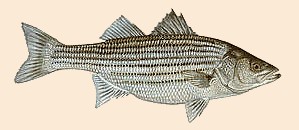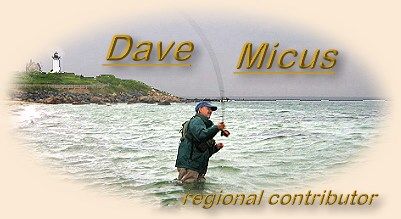|
It's 3:30 am, and I carefully ease myself out
of bed, trying (unsuccessfully, it turns out)
not to disturb the bride. I don't use the alarm,
just will myself to wake, which is something I'm
able to do for fishing but, no surprise, not for
work. High tide is about 7, the rip will begin
forming about 4. The car is already loaded with
my gear, I don't eat or have coffee (always fish
hungry), and I'm on my way by 3:40. I live,
intentionally, 2 minutes by car from where I fish.
The rod is strung up, I put on my waders, and I'm
in the water by 3:45. This is what you do when
you're trying to catch big striped bass.

The sun won't be up for another hour, the moon is
new, and it is dark. Fly-fishing in the dark takes
some getting used to, but conventional wisdom says
the big fish move at night, a Darwinian trait that
helps them avoid predation. And once you become
accustomed to it, it will improve your casting,
this relying on timing alone. But it does take
getting used to. At a breakfast after an all
night fishing tournament, one of the winners
described how he learned to cast at night. "Drink
a martini, then go and cast, then drink another
martini, and go and cast, then drink another,
then go and cast. Keep doing this until you pass
out." "Hey," another competitor said, "that's the
same way I learned about sex."
There are certain precautions you need to take
when fishing at night. It's mandatory that you
know the area you'll be fishing--the rocks, the
holes, the rips. You need to check your fly and
leader every third or fourth cast to make sure
there are no knots or nicks. I'd prefer to fish
an outgoing tide at night, knowing I won't get
stranded by the tide, but where I'm fishing today
only fishes well on the incoming. It's a mussel
bed, to the left of a sand beach. To the right
of the beach the rocky shore juts out, forming a
bowl, and the water sweeps in to the right, past
the rocks, curves along the beach, and sweeps out
over the mussel bed, creating a strong rip. You
need to get in the middle, cast to the right and
let the fly swing into the rip. Then you retrieve
slowly and hope there's a big bass finning behind
a rock, waiting for a vulnerable baitfish to be
swept by. You want to be about thigh deep; shallower
than that and a good part of the water you'll be
fishing will be too skinny, deeper than that and
you'll be swept away.
The ocean shore changes frequently, and this spot
is no different. It used to fish well on the
outgoing tide; there'd be a lot of fish but they'd
all be small. Now it fishes well on the incoming
tide, and there are fewer fish but they tend to be
bigger. The day before I caught a 28.5 incher
here--a keeper by the current criteria, but not
by the old (36 inches) that we still adhere to.
Still, a nice fish.
It's an hour before false dawn, my favorite time
to fish. It requires more than just your sight,
and it can be unnerving to hear but not see fish
feeding, depending on your ears to guide the cast.
Night fishermen sniff the air like dogs, actually
more like bears standing on their hind paws, trying
to pick up a scent. And it is true you can smell
when fish are feeding. This morning there are no
splashes and no smells, and I just cast, drift and
strip.
I'm using a blue back herring pattern with an
epoxy head of my own design. It's been a killer
fly for me, accounting for most of the fish caught.
Killer patterns are deceptive, though--if you fish
only one pattern it stands to reason that you'll
catch all of your fish on that pattern. And it
is rare that the striper will take one fly and
not another; I've only seen a handful of situations
where the bass were taking specific imitations.
Once a friend and I found ourselves in the middle
of acres of feeding bass. He was fishing a Ray's
fly and getting a fish on every cast--even caught
fish after he released a bass and the fly hung in
the water at his feet. I was fishing a fish head,
and catching a fish on every 4th or 5th cast. I
didn't have a Ray's, so I swallowed my pride and
accepted his offer of one. We caught over 80 bass
between us.
The blue back herring pattern is what I caught the
bass on the day before at this very spot. It's a
large fly, with a nice profile, and it has good
action in the water. It's big enough to entice
hefty fish, but still casts easily. It has very
big eyes--an important feature for any striped
bass fly. The eye is a trigger for the bass--having
no real teeth, they swallow their prey from the head
so the dorsal fin will collapse.
It's now five, the rip is moving nicely, and
the sun is just thinking about coming up. The
horizon is just a shade lighter than the water
now, and this is when things happen. I cast
to the right, let the fly swing into the current,
then slowly strip strip strip. And, though I'm
hyper-alert, I still feel that synaptic jolt
when a striper smashes the fly 50 feet away.
I can't see, but I can tell by the splashes
that this is a good-sized bass. Sometimes big
stripers hit a fly near the surface like a shark
hits a seal, driving it right out of the water.
The bass splashes around for a second, then heads
for England.
And this is what it's about, why I get up a 3 am,
stand up to my butt in freezing cold water, hungry,
tired, thirsty. That one big fish. The reel buzzes
like a dentist's drill, the orange backing blurs
through the guides, and the line goes slack.
Dammit.
I reel in, thinking the knot is bad, but the fly
is still on. Hook seems sharp, but it didn't set.
On a big fish you need to set the hook three, four,
five times. And there was my mistake.
The sun is just starting to break the horizon.
The cloud cover makes the sky vivid red, and
the water, too, turns red from the reflection.
I cast a few more times but my heart isn't in
it; I know from experience that this spot, for
some odd reason, only gives you one shot. I
pick up three schoolies, small for stripers,
nice size for trout, 17 inches or so. I hold
them by the lower jaw and work the barbless hook
free. I lower them to the water and let go, and
they are off with one quick swipe of their tail.
I can go from here to Gould's Creek which fishes
well from high until two hours after; from Gould's
to Crane beach to fish until two hours before low.
Then on to the river mouth until low, then to the
slot off of Little Neck Road that holds fish at
slack low. Then to the lobster boats and fish
until the tide forces me off of the sand bar.
That would take me until 3 pm, 11 hours of fishing.
But there is wood that needs stacking and grass
that needs mowing and I have promises to keep - at
least until tomorrow, at 4:50 when the tidal rip
will once again surge over the mussel bed at
Pavilion Beach. ~ Dave
About Dave:
 Dave Micus lives in Ipswich, Massachusetts. He is an
avid striped bass fly fisherman, writer and instructor.
He writes a fly fishing column for the Port City Planet
newspaper of Newburyport, MA (home of Plum Island and Joppa Flats)
and teaches a fly fishing course at Boston University.
Dave Micus lives in Ipswich, Massachusetts. He is an
avid striped bass fly fisherman, writer and instructor.
He writes a fly fishing column for the Port City Planet
newspaper of Newburyport, MA (home of Plum Island and Joppa Flats)
and teaches a fly fishing course at Boston University.
|





